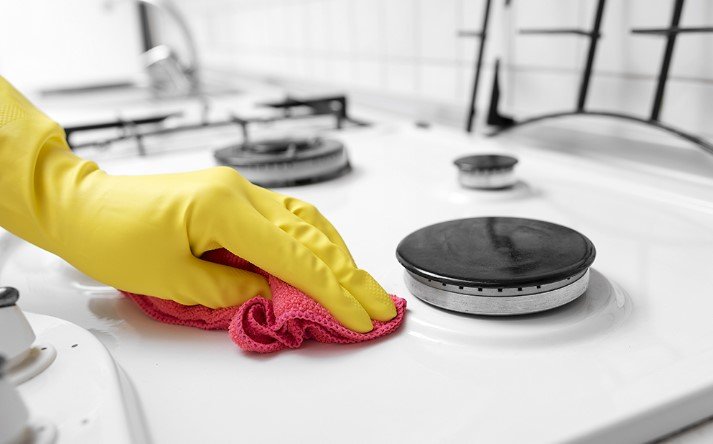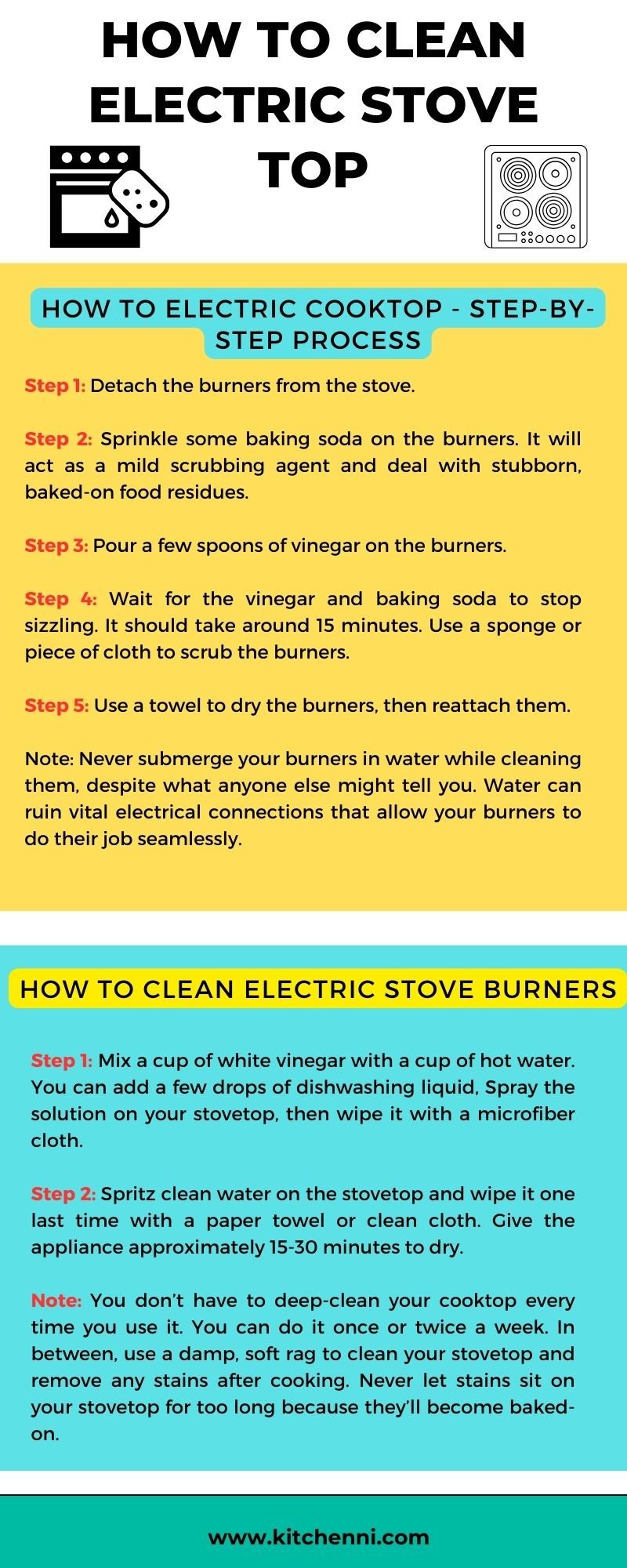Your stove top endures a lot – oil splatters, food spills, boiled-over messes. It’s practically a battleground. Even wonderful meals can leave stubborn stains cemented on your stove if you don’t take care of it. If your electric stove is a victim, we will guide you on how to do it right!
With a few simple tools and cleaning agents, you can beat that crud and have your stove looking fresh and spotless in no time. No need for heavy-duty chemicals or elbow grease that might damage the appliance. This straightforward guide will walk you through an electric stove cleaning step-by-step using ingredients you likely have in your pantry.
Generally, here are all the ways to clean your electric stovetop
How to Clean Electric Stove Top Infographic
Best Way to Clean Electric Cooktop – Step-by-Step Process
Here’s how you should clean your electric stovetop:
- Before diving into the actual cleaning, ensure your cooktop is cool. According to the American Burn Association, 72% of burns occur at home. You can’t be too careful. If you’ve cooked with your appliance, let it sit and cool down for approximately 10 minutes.
- If your stovetop has any burned-on food residue or stubborn grime, use a scraper to get rid of it. Do it gently to avoid scratching the appliance. Don’t use the corners of the scraper blade because they’ll etch the stovetop’s pristine surface and do more harm than good. Wipe away all the scraped debris and any food crumbs.
- Mix a cup of white vinegar with a cup of hot water. You can add a few drops of dishwashing liquid, but that’s optional. Spray the solution on your stovetop, then wipe it with a microfiber cloth.
- Spritz clean water on the stovetop and wipe it one last time with a paper towel or clean cloth. Give the appliance approximately 15-30 minutes to dry.
- You don’t have to deep-clean your cooktop every time you use it. You can do it once or twice a week. In between, use a damp, soft rag to clean your stovetop and remove any stains after cooking. Never let stains sit on your stovetop for too long because they’ll become baked-on, stubborn stains that will be significantly harder to eliminate.
How To Clean Electric Stove Burners
The burners in electric stovetops often get soiled by food and liquid spills. So, after using your cooker, let the burners cool down, then use a damp rag to remove spills, grease, and food particles. Also, while deep cleaning your stovetop, don’t forget to give the burners some TLC. Follow these steps:
- Detach the burners from the stove. If you don’t know how to do that, check the user manual that came with your appliance.
- Sprinkle some baking soda on the burners. It will act as a mild scrubbing agent and deal with stubborn, baked-on food residues.
- Pour a few spoons of vinegar on the burners. That is essential in breaking down grease stains.
- Wait for the vinegar and baking soda to stop sizzling. It should take around 15 minutes. Use a sponge or piece of cloth to scrub the burners.
- Use a towel to dry the burners, then reattach them.
- Never submerge your burners in water while cleaning them, despite what anyone else might tell you. Water can ruin vital electrical connections that allow your burners to do their job seamlessly.
How To Clean Electric Stove Coils
Cleaning electric stove coils is easy. Just do the following:
- Detach the coils
- Dip a towel in soapy water and use it to clean the coils
- If your coils have stubborn stains, use a scrub sponge to get rid of them
- Reattach the coils
In most cases, electric stove coils cook off food spills and residue. Therefore, you will rarely come across coils with baked-on grime. But, if you do, use baking soda and vinegar to get rid of it.
How To Clean Electric Stove Drip Pans
My electric stove has drip pans installed underneath the burners. If your appliance has these components, the following steps can help you clean them:
- Remove the drip pans. Before you do that, you have to detach the burners from their sockets.
- Fill your kitchen sink with hot water. The water should be hot enough to soften stubborn gunk and make cleaning easier.
- Add a few drops of dishwashing soap to the water.
- Soak the drip pans in the water for 10-15 minutes.
- Wipe the drip pans with a dishcloth or sponge.
- If you encounter any stubborn stains, use a scrub sponge and baking soda to remove them.
If your drip pans are too dirty and need something advanced, use ammonia to clean them. This chemical has always done wonders for me. Follow these steps:
- Rinse the dirty drip pans with hot water, then put each component in a 1-gallon ziplock plastic bag.
- Fill each bag with ¼ cup of household ammonia. Ensure the solution doesn’t touch your hands because it can cause severe burns.
- Seal the bags and let the drip pans soak for at least 12 hours. The drip pans don’t have to be 100% submerged in ammonia. If you see portions that aren’t coated, don’t worry. The fumes will still do the trick.
- Remove the drips from the plastic bags. Do it in a well-ventilated area to avoid inhaling the toxic fumes, which can lead to various issues, from mild throat irritation to blindness.
- Dilute the ammonia with cold water and pour it down the sink. Then, seal the used plastic bags and dispose of them.
- Rinse the drip pans with clean water. If you see any dirty spots, use dish soap and a sponge to deal with them.
- Dry the clean drip pans and put them back where they belong.
How Do You Remove Tough Grime and Burnt Grease from a Stove Top?
A mixture of baking soda and vinegar can help you remove burnt-on grease and stubborn stains from your stovetop.
- Mix baking soda and vinegar in a bowl.
- Spread the paste over your stovetop and let it sit for 15-20 minutes.
- Use a non-abrasive utensil scrubber to scrub the area with the paste. Rinse with a sponge and clean water.
- Use a lint-free piece of cloth to dry the stovetop.
What’s the Best Electric Stovetop Cleaner Do I Use?
I often use the following remarkable electric stovetop cleaning products to clean my appliances:
1. Weiman Stainless Steel Cleaner and Polish

This cleaning product is for stainless-steel appliances. It eliminates all unwanted stains, from grease and watermarks to caked-on food residue and fingerprint marks. Besides my electric cooktop, I use the Weiman Stainless Steel Cleaner and Polish to clean my oven, outdoor grill, dishwasher, refrigerators, etc.
2. Goo Gone Kitchen Degreaser

If your cooktop isn’t made of stainless steel, ditch the first product for the Goo Gone Kitchen Degreaser. With it, removing the toughest grime and gunk from your stovetop will be a breeze. You can also use it to clean your kitchen range hood, counters, utensils, and more.
3. Stardrops – The Pink Stuff

Stardrops’ all-purpose cleaning purpose claims to be a miracle product that, get this, works like a miracle. I can’t refute that. I’ve tried it and was impressed by its ability to remove grime and stubborn stains from almost anything, including my beloved electric stovetop. Try it today.
4. Easy Off Heavy-Duty Degreaser

As the name suggests, the Easy Off Heavy-Duty Degreaser is tailored for the toughest gunk and grease spills. Unfortunately, you can’t use it on aluminum surfaces because it contains certain chemicals that can ruin them.
Products to Avoid
If you don’t want to damage your electric stovetop while cleaning it, avoid the following like the plague:
- Abrasive cleaners like bleach or ammonia
- Steel wool and other abrasive sponges
- Using everyday razor blades to scrape off burnt-on gunk
- Commercial glass cleaning products like Windex
- Wire brushes
How Often You Should Clean Your Stove Top?
You should clean your stovetop after every use. That will help you remove spills and stains before they become a headache. Also, deep clean your appliance at least once a week. Never let your cooktop go without cleaning for too long because grime will accumulate on its surface, making it unpleasant to look at. Also, a dirty cooktop exposes you to various health issues, including lung cancer.
How to Prevent Burns and Messes?
The following tips can help you prevent burns and messes while using your electric cooktop:
- Don’t stuff your pots or pans with too much food
- Use a splatter guard to prevent grease splatters while frying, sauteing, or searing food
- Deal with spilled food and liquids as quickly as possible
- Ensure your little ones know the kitchen is a no-go zone while cooking is underway
- Use oven mitts to grab cookware while cooking
Final Thoughts
Frequently cleaning your stovetop is the only way to ensure it remains in pristine condition. Wipe away spills, stains, and crumbs after cooking. And every once or twice a week, take some time to deep-clean your appliance and its components.
I’ve provided different guides for dealing with everything, from your cooktop’s top surface to the burners and drip pans. If you follow them to the letter, your electric stove will always make you smile whenever you enter your kitchen. So roll up your sleeves and get down to it.
Common Questions
Should I clean my electric stove when it’s hot or cold?
It’s best to clean the stove when it is completely cool. Cleaning the stove when hot can lead to burns or damage to the surface. Make sure all burners are turned off and cooled before cleaning.
What is the proper way to clean the burner grates?
Use a damp cloth or sponge with dish soap to wipe down the grates. For stuck-on food, lay the grates in your sink or on a towel and scrub them with baking soda and a scouring pad. Rinse and dry thoroughly before replacing.
How do I clean burned-on stains on the stove surface?
Use a razor blade scraper held at a 30° angle to gently lift any hardened spills or caked-on food. Then apply baking soda and scrub with a damp sponge in a circular motion. Rinse and wipe away excess. Vinegar can also help dissolve stubborn stains.
What’s the best way to make the stove surface shine?
Use a glass cleaner like Windex or mix equal parts vinegar and water for an all-natural solution. Spray or wipe onto the surface and buff dry with a microfiber cloth or paper towels. Aluminum foil can also polish and brighten the electric stove top.
How often should I fully clean my electric stove?
Do a thorough clean 1-2 times per month. Quick wipe-downs after each use will keep the stove looking tidy between deep cleans. Check for any missed spills under burner grates when doing monthly cleaning.
What should I avoid using to clean the electric stove?
Avoid abrasive scouring pads, steel wool, and harsh chemical cleaners like bleach or oven cleaners, as these can damage the stove surface. Also, avoid getting the control panel or burners excessively wet.




